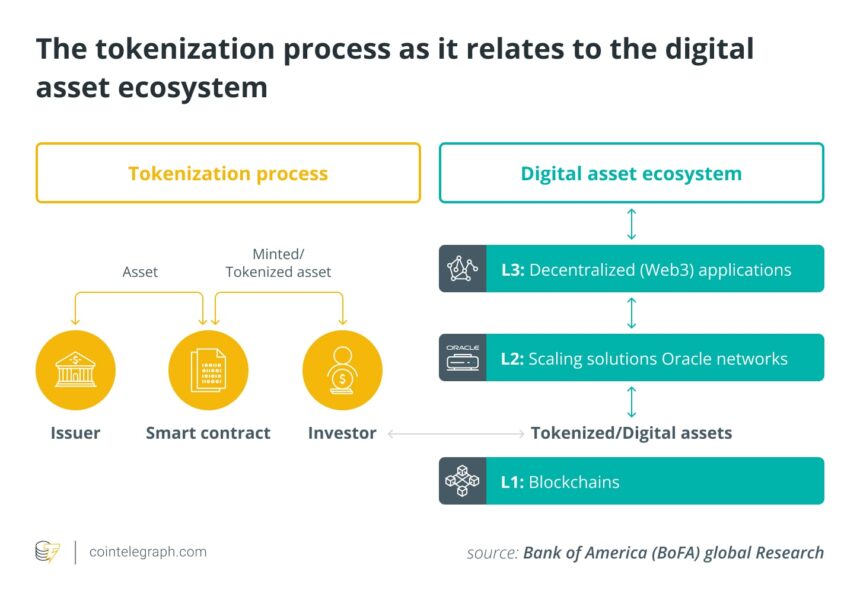Real-world asset (RWA) tokenization is an emerging concept that traces back to the advent of blockchain technology. The journey began with Bitcoin’s introduction in 2009, which unveiled a decentralized, secure, and transparent ledger system.
This groundbreaking technology laid the foundation for turning physical assets into digital tokens recorded on a blockchain. However, the real leap forward came with Ethereum in 2015, introducing smart contracts —self-executing agreements coded directly onto the blockchain.
With smart contracts, it became possible to digitally represent physical assets like real estate, art, and commodities, bridging the gap between the physical and digital worlds. The potential for this technology to impact global economies and social structures quickly became apparent.
Why do RWAs matter?
To understand the significance of RWA tokenization, picture a large pizza you want to share with friends. Instead of giving each friend the whole pizza, you slice it into pieces, with each slice representing part of the whole.
Tokenization works similarly with assets. When an asset is tokenized, it’s divided into smaller parts called “tokens,” each representing a share of the asset. These tokens can represent anything valuable, from real estate to intellectual property. Managed and traded using blockchain technology, these tokens ensure secure and transparent ownership records, making assets more accessible, liquid, and tradable globally.
The impact of tokenization
Consider the real estate market in cities like New York or London. A $10 million property could be divided into 10 million tokens at $1 each. This enables individuals to invest as little as $100, owning a slice of high-value real estate.
Tokenization brings liquidity to the real estate market, which is traditionally illiquid and difficult for smaller investors to access. According to MarketsandMarkets, the global real estate tokenization market is projected to reach $1.4 trillion by 2026, growing at a CAGR of 22.8%.
The same principle applies to commodities. An ounce of gold worth $2,000 can be tokenized into 2,000 shares at $1 each. This lowers the barrier to entry, allowing more investors to gain exposure to commodities without needing significant capital. Grand View Research forecasts the tokenized commodities market to reach $4.5 billion by 2025.
Tokenization also empowers creators to monetize their intellectual property. A patent valued at $1 million could be divided into 1 million tokens at $1 each. Investors can purchase these tokens and share in the revenue generated, rewarding creators while opening up investment opportunities to a broader audience. Juniper Research predicts the market for tokenized intellectual property rights will reach $320 million by 2025.

Even private equity and venture capital, traditionally reserved for the wealthy, can be democratized through tokenization. A $100 million venture capital fund could be divided into 100 million tokens at $1 each, enabling smaller investors to participate in early-stage investment opportunities previously out of reach. The Boston Consulting Group projects tokenized private equity markets to reach $1.7 trillion by 2030.
The social aspect of RWA tokenization
Beyond economic gains, RWA tokenization has profound social implications, particularly in advancing financial inclusion. In many parts of the world, access to traditional financial markets is limited by geography, income, and infrastructure. Tokenization can bridge these gaps, enabling people from all economic backgrounds to participate in wealth creation using just a smartphone and an internet connection.

In developing economies where banking infrastructure is lacking, this empowerment can help millions build wealth and improve their economic standing. It can lead to broader societal benefits like reduced poverty and increased access to education and healthcare. By democratizing investment opportunities, tokenization fosters a more inclusive and equitable global economy.
The numbers speak volumes. The World Economic Forum estimates that by 2030, the tokenized real-world assets market could reach $16.1 trillion, accounting for about 10% of global GDP.
Why is RWA tokenization essential to make a social and economic impact?
The potential of real-world asset tokenization to transform global finance is immense. From real estate and art to commodities and intellectual property, tokenization enables individuals from diverse economic backgrounds to participate in wealth creation and asset appreciation.
Adoption of RWAs can and will reduce economic disparities, offering financial inclusion to the unbanked and underserved. Legally, it challenges traditional ownership structures, potentially leading to more equitable property rights. Politically, it may shift power dynamics by distributing economic influence more widely. Economically, it can stimulate growth in emerging markets by unlocking local asset value and attracting global investment.
Regulatory cooperation, technological innovation, and widespread education are crucial to realizing these benefits, especially in regions with limited financial infrastructure.
In this evolving landscape, companies like Brickken are at the forefront of making RWA tokenization a reality. Since 2020, Brickken has tokenized over $230 million worth of assets across 11 countries. By providing tools for the creation, sale, and management of digital assets, they’re actively shaping a future where financial opportunities are truly democratized.
Brickken’s work exemplifies how technology can be harnessed to create a more inclusive and equitable financial system. They’re not just participating in this revolution—they’re leading it, paving the way for a world where everyone, regardless of economic background, can participate in and benefit from real-world assets.
Source: https://cointelegraph.com/news/a-brief-history-of-real-world-assets-why-they-matter



